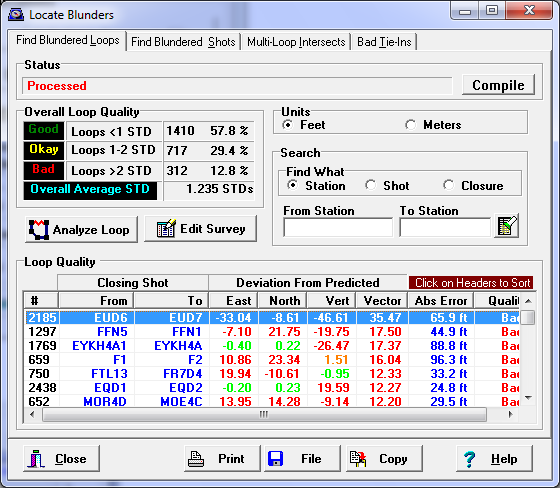Compass has the ability to help you locate blunder and gross errors in your survey data. It does this by intensely analyzing the type and configuration of errors in survey loops. In many cases, it can pinpoint the exact shot and measurement that is the blunder. You can begin analyzing blunders by selecting the "View -> Find Blunders" option from the menu bar.
Overview. The blunder detection software uses information gathered by the Compiler to analyze and locate blunders. For this reason, before you can view statistics, you must process your cave data.
You can do this in several ways. If you have used the “Process and View” button to view the cave, the information may have already been generated. However, depending on how the options have been set, Compass may be working from files on disk and so the information will not be available. If this is the case, you can use the Compile button in the Blunder Window to generate statistics. You can also access this option by selecting the Run|Process Only option from the menu bar..
Blunder Information Source. The Compiler and Loop Closer only operate on the files you have selected in the survey tree |
|
As a consequence, the blunder data you see will depend upon which files have been highlighted in the tree. If an individual survey data file was highlighted when you processed the data, only the blunder data for that file will be available. On the other hand, if the survey project was highlighted, blunder data for all files in the project will be available. Remember that linking causes the program to purge certain information as the files are processed. Thus, if you are linking, the blunder information may be incomplete.
Compiling vs. Closing. When you compile and close the data normally, the Compiler will be using closed data files and thus loop errors will be masked. This can be useful if you want to verify that the Loop Closer is truly closing the cave. However, it you want to analyze loop errors or look for blunders, you must be certain that the Compiler doesn’t use closed data files.
The Blunder Window. The Blunder Window consists of four pages, each of which performs part of the Blunder Location task. To select one of the pages, simply
![]()
Here is list of Blunder Location pages and additional information:
Blunder Window Pages |
|
|
Additional Information |
